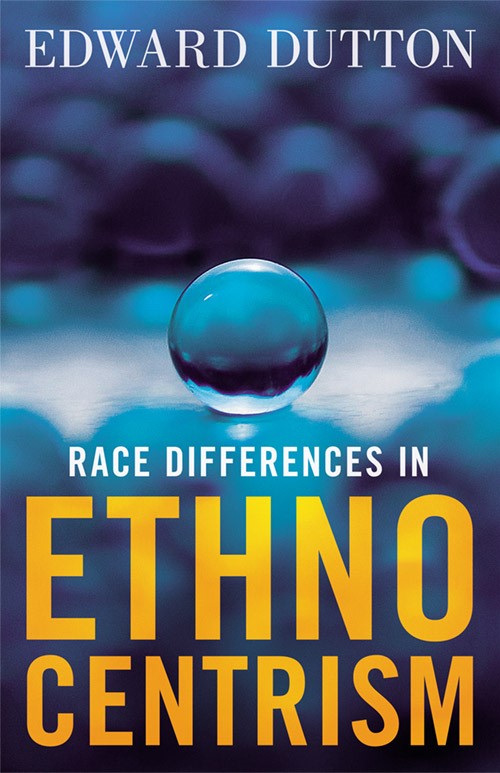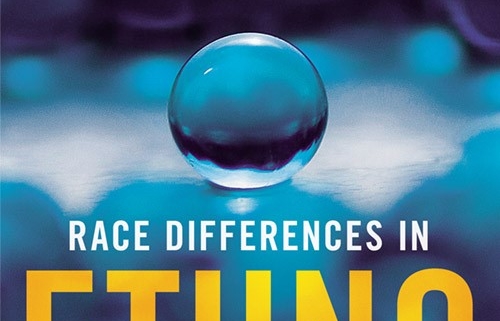Review of Ed Dutton’s Race Differences in Ethnocentrism
 Race Differences in Ethnocentrism
Race Differences in Ethnocentrism
Edward Dutton
Arktos, 2019.
“Those who advocate Multiculturalism seem to have lost an important instinct towards group — and thus genetic — preservation. Once a society, as a whole, espouses Multiculturalism as a dominant ideology then the society is acting against its own genetic interests and will ultimately destroy itself.”
Ed Dutton
Watching his incredibly entertaining Jolly Heretic You Tube channel, it’s easy to forget that Ed Dutton is also an extremely serious, and increasingly prolific, researcher, author, and scientist. The recent publication by Arktos of Dutton’s Race Differences in Ethnocentrism follows closely in the wake of Dutton’s At Our Wits’ End: Why We’re Becoming Less Intelligent and What it Means for the Future (2018), How to Judge People by What They Look Like (2018), J. Phillipe Rushton: A Life History Perspective (2018), and The Silent Rape Epidemic: How The Finns Were Groomed to Love Their Abusers (2019). In Race Differences in Ethnocentrism, Dutton, who has collaborated with Richard Lynn on a number of occasions, builds impressively on the work of the latter and has offered, in this text, one of the most informative, formidable, pressing, intriguing, and poignant monographs I’ve read in years.
Dutton’s book is a work of science underscored by an inescapable sense of social and political urgency, and has been explicitly prompted into being by the need to address two questions “particularly salient during a period of mass migration”: ‘Why are some races more ethnocentric than others?’ and, most urgently of all, ‘Why are Europeans currently so low in ethnocentrism?’ In attempting to answer these questions, Dutton has designed a book that is accessible to readers possessing even the most modest scientific knowledge, without compromising on academic rigor or the use of necessary scientific language. The text is helpfully replete with explanatory commentary and useful rhetorical illustrations, and its opening four chapters are dedicated exclusively to placing the study in context and exploring the nature of the research itself. This is a book that can, and should, be read by everyone.
In the brief first chapter, Dutton explains ethnocentrism or group pride as taking two main forms. The first, positive ethnocentrism, involves “taking pride in your ethnic group or nation and being prepared to make sacrifices for the good of it.” Negative ethnocentrism, on the other hand, “refers to being prejudiced against and hostile to members of other ethnic groups.” Typically, a highly ethnocentric person or group will demonstrate both positive and negative ethnocentrism, although it is very common for people and groups to be high in one aspect of ethnocentrism but not in the other. It is also apparent that some countries and ethnic groups are very high in both forms of ethnocentrism while others are extremely low in the same. The author sets out to explore how and why such variations and differences have occurred, and are still fluctuating. This is clearly a piece of very novel research. Dutton remarks that “there exists no systematic attempt to understand why different ethnic groups may vary in the extent to which they are ethnocentric.” Dutton’s foundation is built on a deep reading of existing literature on the origins and nature of ethnocentrism, pioneered to some extent by R. A. LeVine and D. T. Campbell in the 1970s, and built upon most recently by Australia’s Boris Bizumic. These scholars advanced the argument that ethnocentrism was primarily the result of conflict. Another highly relevant theory in the study of ethnocentrism has been the concept of ‘inclusive fitness,’ which argues that ethnocentrism provides a method for indirectly passing on one’s genes.
Dutton closes his introductory chapter by providing an interesting overview of historical observations of differences in ethnocentrism. During the so-called ‘Age of Discovery,’ Europeans encountered large numbers of different and distant tribes, and many remarked on the reception they received from these groups. Some, such as the natives of Hawaii and the Inuit were noted as being extremely friendly, while the negrito tribes of the Andaman Islands, near India, remain notoriously hostile to outsiders, shoot arrows at passing aircraft, and kill intruding foreigners, including an American missionary in November 2018. The Japanese appear throughout history to have combined a moderate level of negative ethnocentrism with very high levels of positive ethnocentrism, resulting in a society typified by high levels of social harmony and in-group co-operation, and willing sacrifice for the nation in times of war. By contrast, the Yąnomamö tribe of Venezuela are very high in negative ethnocentrism but very low in positive ethnocentrism, resulting in a society riddled with lawlessness, extreme violence, poor social harmony, and an inability to form stable social structures of any kind. Differences in general levels of ethnocentrism are important because, as Dutton points out, those societies most welcoming of outsiders were subsequently colonized and fundamentally and permanently changed by migration. Meanwhile, those societies that displayed extreme hostility to outsiders have remained almost intact, and remain unchanged even centuries after the European ‘Age of Discovery.’ Read more








